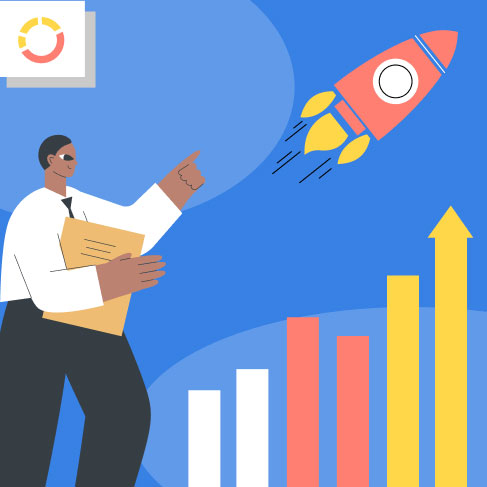Maturity Stage of Product Life Cycle: Five Strategies to Stay on Top
August 9, 2023 | Read Time : 3 mins
Table of Contents
Every product goes through a lifecycle consisting of introduction, growth, maturity, and decline stages. The maturity stage is a critical phase where products face intense competition, and the market becomes saturated.
However, companies can maintain their market position and thrive with the right strategies. In this blog, we will explore five effective strategies to stay on top during the maturity stage of the product life cycle. But before that, a short introduction on Product Life Cycle.

Product Life Cycle and Its Different Stages
A. Introduction Stage: The introduction stage marks the initial launch of a new product in the market. During this phase, businesses invest heavily in research and development, product design, and marketing efforts. Customers become aware of the product’s existence, but sales are generally low due to limited brand recognition and the need for market education.
- High promotional and marketing expenses to create awareness.
- Limited distribution channels as companies test the market response.
- Low sales and minimal profitability.
- Customers who adopt the product early are known as innovators and early adopters.
B. Growth Stage: As the product gains momentum, it enters the growth stage. During this phase, sales start to increase rapidly, and the product becomes more profitable. With growing brand awareness and positive word-of-mouth, the product attracts a broader customer base. Competitors may enter the market during this stage, leading to increased competition.
- Rapid sales growth and increasing market share.
- Expanded distribution channels to meet the rising demand.
- Pricing stability or slight reductions due to economies of scale.
- More customers from the early majority and mainstream market segments.
C. Maturity Stage: The maturity stage is characterized by a stable phase in product sales. The market becomes saturated, and sales growth plateaus. Competition is fierce, and companies may engage in price wars to maintain market share. Customer preferences have largely settled, and new customer acquisition becomes challenging.
- Slower sales growth or stagnant sales.
- Intense competition with a focus on differentiation.
- Market saturation and the possibility of declining sales.
- Majority of customers come from the mainstream market segments.
D. Decline Stage: The decline stage signals a decrease in demand for the product. It can be caused by market saturation, technological advancements, changing customer preferences, or the emergence of superior alternatives. During this stage, companies must decide whether to discontinue the product or revitalize it.
- Declining sales and market share.
- Reduced profitability due to diminishing demand.
- Company may consider product phase-out or replacement.
- A shrinking customer base and limited opportunities for growth.
1. Enhance Differentiation
- Refine and Innovate: Continuous refinement and innovation are essential to stand out from competitors. Regularly assess your product’s features, design, and functionality to identify areas for improvement. Seek customer feedback, conduct market research, and invest in R&D to develop new features or upgrades that meet evolving customer needs. By staying ahead of the curve, you can maintain a unique selling proposition and attract new customers even in a mature market.
- Improve User Experience (UX): Customers have a wide range of choices in the maturity stage. Offering an exceptional user experience becomes paramount to differentiate your product. Conduct user research to understand their pain points and preferences. Utilize the insights gained to enhance your product’s usability, simplicity, and intuitiveness. Optimize the user interface, streamline workflows, and invest in responsive customer support to create a delightful experience that keeps customers returning.
- Focus on Branding and Positioning: Strong branding and effective positioning are crucial to maintaining a competitive edge in the mature market. Continuously reinforce your brand identity through consistent messaging, visual elements, and personality. Develop compelling marketing campaigns that emphasize your product’s unique value to customers. Consider targeted advertising, partnerships, or endorsements to reach new audiences and reinforce your market position.
2. Expand Market Reach
- Target New Customer Segments: While your product may have initially targeted a specific customer segment, the maturity stage presents an opportunity to explore new markets. Conduct market research to identify untapped customer segments that can benefit from your product. Adapt your marketing strategy and messaging to resonate with these segments, highlighting how your product can address their unique needs. Expanding your customer base can counterbalance the decline in demand from the original segment.
- Geographical Expansion: Exploring new geographical markets is another way to counter saturation. Assess market potential in different regions and evaluate the feasibility of expanding your product’s reach. Localize your product, marketing materials, and customer support to cater to the cultural nuances and preferences of the new market. Collaborate with local partners, distributors, or resellers to establish a strong presence and gain traction in untapped regions.
- Diversify Distribution Channels: In the maturity stage, optimizing your distribution channels can help you maintain a competitive edge. Explore new avenues such as e-commerce platforms, mobile apps, or partnerships with retailers to reach a broader customer base. Consider offering subscription-based models, freemium versions, or value-added services to attract new customers and retain existing ones. Embrace digital transformation to streamline distribution processes and enhance customer convenience.
3. Leverage Data and Analytics
- Customer Insights: In the maturity stage, data and analytics play a vital role in understanding customer behaviour and preferences. Leverage user analytics, surveys, and feedback mechanisms to gain insights into how customers use your product, what features they value the most, and areas needing improvement. Utilize this data to make data-driven decisions, prioritize product enhancements, and tailor your marketing campaigns to address specific customer needs.
- Competitive Analysis: Competitor analysis becomes even more critical during the maturity stage. Monitor the activities of your competitors closely, including their product offerings, pricing strategies, marketing campaigns, and customer feedback. Identify gaps in the market and differentiate yourself by addressing customer pain points that your competitors have overlooked. Continuous benchmarking and staying ahead of competitors will help you retain market share and remain on top.
- Predictive Analytics and Forecasting: As the maturity stage progresses, accurate demand forecasting becomes crucial to optimize production, inventory, and resource allocation. Leverage predictive analytics and historical data to forecast future demand patterns. You can minimize the risk of stockouts or overstock by understanding seasonal fluctuations, market trends, and customer behaviour. This allows you to maintain efficient operations, reduce costs, and meet customer demands effectively.
4. Pricing Strategy
- Value-Based Pricings: In the maturity stage of the product life cycle, customers are more aware of the value they derive from a product. Adopting a value-based pricing strategy can help maximize revenue and maintain a competitive position. Evaluate the unique value proposition your product offers and align pricing with customers’ perceived value. Consider tiered pricing models, offering different feature sets or levels of service at varying price points to cater to different customer segments. Regularly assess market dynamics and competitor pricing to ensure your pricing remains competitive and provides a fair value exchange.
- Promotional Strategies: In the maturity stage, promotional strategies can be crucial in maintaining market share and attracting new customers. Develop targeted promotional campaigns that highlight the key differentiators of your product and communicate the value proposition to potential customers. Leverage various marketing channels such as social media, content marketing, email marketing, and partnerships to reach a wider audience. Consider offering limited-time discounts, bundle offers, or loyalty programs to incentivize new purchases and encourage customer retention.

5. Customer Retention and Loyalty
- Customer Success Program: Customer retention becomes increasingly important during the maturity stage. Implement a customer success program to proactively engage with customers and ensure they achieve their desired outcomes with your product. Offer training resources, tutorials, and proactive support to help customers maximize the value they derive from your product. Regularly check in with customers to gather feedback, address concerns, and identify opportunities for upselling or cross-selling. Building strong relationships with customers can lead to increased customer loyalty and advocacy.
- Loyalty and Referral Programs: Encourage customer loyalty and referrals by implementing loyalty and referral programs. Reward existing customers for their loyalty with exclusive benefits, discounts, or access to premium features. Offer incentives for customers who refer new customers to your product, such as discounts or referral bonuses. By leveraging the power of customer referrals and nurturing customer loyalty, you can drive customer retention, expand your customer base, and reduce acquisition costs.






